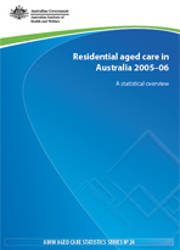Summary
The number of residential aged care places increased from 161,765 at 30 June 2005 to 166,291 places at 30 June 2006. The 166,291 places include 2,273 places provided by Multi- Purpose Services and places funded under the Aboriginal and Torres Strait Islander Aged Care Strategy. There were a total of 2,931 mainstream residential aged care services with an average number of funded places per service of 60.
The provision ratio of residential aged care places per 1,000 persons aged 70 years and over increased from 85.3 at 30 June 2005 to 85.6 at 30 June 2006. The planning target ratio is currently 88. Including community services covered by the Aged Care Act (1997), the corresponding ratio of places and packages increased from 102.5 to 105.8 during the 12 month period to 30 June 2006, relative to the planning target of 108.
The highest state/territory provision ratio for residential aged care was South Australia (92.2), and the lowest was the Australian Capital Territory, (72.1). Provision was lower in outer regional (76.2) and remote areas (65.7).
Fifty-three per cent of the 154,872 residents at 30 June 2006 were aged 85 years and older, continuing the upward trend over time in the age profile of residents. Women comprised 72% of the residential aged care population and 58% of these female residents were aged 85 years and over compared with 38% of male residents. Overall, about 4% of residents were less than 65 years in age.
In terms of dependency, 69% of residents at 30 June 2006 were assessed as high care and 63% of admissions over the year from 1 July 2005 to 30 June 2006 were initially assessed as high care. At the point of separation over the same year, 86% of residents had high-care status.
There were 102,691 admissions to residential aged care between 1 July 2005 and 30 June 2006, excluding transfers. 52,964 admissions were for ongoing care and the remainder were for shorter term respite care. There were 50,720 separations after a period of permanent care; the most common reason for separation was death (87%). There were 49,402 separations after a period of respite care; the vast majority of these residents (78%) returned to the community.
The average completed length of stay was 145.8 weeks for permanent residents and 3.1 weeks for respite residents.
Usage rates at 30 June 2006 were calculated for a number of groups in permanent residential aged care. Usage rates increase substantially at older ages, varying from 6 people per thousand at ages 65–69 to 237 per 1,000 at ages 85 and over. Usage rates are higher for Indigenous people than for non-Indigenous people in every age group, although the difference is smaller at older ages. Amongst those aged 65–69 years, the rate for Indigenous people was 17 per 1,000 compared to 6 per 1,000 for non-Indigenous people. At age 75 years and over, the rates were 105 per 1,000 for Indigenous people and 101 per 1,000 for non- Indigenous people.



